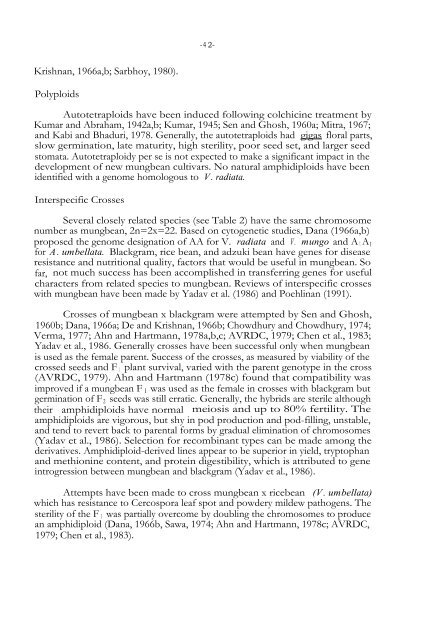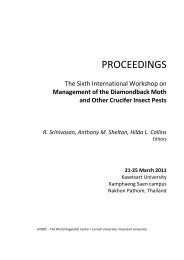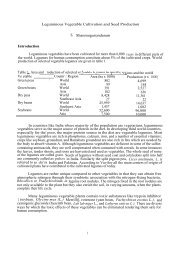MUNGBEAN VARIETAL IMPROVEMENT S. Shanmugasundaram
MUNGBEAN VARIETAL IMPROVEMENT S. Shanmugasundaram
MUNGBEAN VARIETAL IMPROVEMENT S. Shanmugasundaram
Create successful ePaper yourself
Turn your PDF publications into a flip-book with our unique Google optimized e-Paper software.
- 4 2-<br />
Krishnan, 1966a,b; Sarbhoy, 1980).<br />
Polyploids<br />
Autotetraploids have been induced following colchicine treatment by<br />
Kumar and Abraham, 1942a,b; Kumar, 1945; Sen and Ghosh, 1960a; Mitra, 1967;<br />
and Kabi and Bhaduri, 1978. Generally, the autotetraploids had gigas floral parts,<br />
slow germination, late maturity, high sterility, poor seed set, and larger seed<br />
stomata. Autotetraploidy per se is not expected to make a significant impact in the<br />
development of new mungbean cultivars. No natural amphidiploids have been<br />
identified with a genome homologous to V. radiata.<br />
Interspecific Crosses<br />
Several closely related species (see Table 2) have the same chromosome<br />
number as mungbean, 2n=2x=22. Based on cytogenetic studies, Dana (1966a,b)<br />
proposed the genome designation of AA for V. radiata and V. mungo and A L A I<br />
for A. umbellata. Blackgram, rice bean, and adzuki bean have genes for disease<br />
resistance and nutritional quality, factors that would be useful in mungbean. So<br />
far, not much success has been accomplished in transferring genes for useful<br />
characters from related species to mungbean. Reviews of interspecific crosses<br />
with mungbean have been made by Yadav et al. (1986) and Poehlinan (1991).<br />
Crosses of mungbean x blackgram were attempted by Sen and Ghosh,<br />
1960b; Dana, 1966a; De and Krishnan, 1966b; Chowdhury and Chowdhury, 1974;<br />
Verma, 1977; Ahn and Hartmann, 1978a,b,c; AVRDC, 1979; Chen et al., 1983;<br />
Yadav et al., 1986. Generally crosses have been successful only when mungbean<br />
is used as the female parent. Success of the crosses, as measured by viability of the<br />
crossed seeds and F 1 plant survival, varied with the parent genotype in the cross<br />
(AVRDC, 1979). Ahn and Hartmann (1978c) found that compatibility was<br />
improved if a mungbean F l was used as the female in crosses with blackgram but<br />
germination of F 2 seeds was still erratic. Generally, the hybrids are sterile although<br />
their amphidiploids have normal meiosis and up to 80% fertility. The<br />
amphidiploids are vigorous, but shy in pod production and pod-filling, unstable,<br />
and tend to revert back to parental forms by gradual elimination of chromosomes<br />
(Yadav et al., 1986). Selection for recombinant types can be made among the<br />
derivatives. Amphidiploid-derived lines appear to be superior in yield, tryptophan<br />
and methionine content, and protein digestibility, which is attributed to gene<br />
introgression between mungbean and blackgram (Yadav et al., 1986).<br />
Attempts have been made to cross mungbean x ricebean (V. umbellata)<br />
which has resistance to Cercospora leaf spot and powdery mildew pathogens. The<br />
sterility of the F l was partially overcome by doubling the chromosomes to produce<br />
an amphidiploid (Dana, 1966b, Sawa, 1974; Ahn and Hartmann, 1978c; AVRDC,<br />
1979; Chen et al., 1983).

















